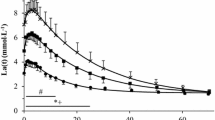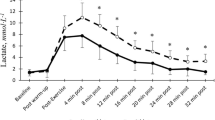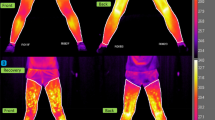Summary
Lactate, glycerol, and catecholamine in the venous blood after 400-m and 3,000-m runs were determined in eight sprint runners, eight long distance runners, and seven untrained students. In 400-m sprinting, average values of velocity, peak blood lactate, and adrenaline were significantly higher in the sprint group than in the long distance and untrained groups. The mean velocity of 400-m sprinting was significantly correlated with peak blood lactate in the untrained (r=0.76,P<0.05) and long distance (r=0.71,P<0.05) groups, but not in the sprint group. In the 3,000-m run, on the other hand, average values of velocity and glycerol were significantly higher in the long distance group than in the sprint and untrained groups, but there are no significant differences in lactate levels between the three groups. These results suggest that 1) performance in 400-m sprinting may depend mainly upon an energy supply from glycolysis in the long distance and untrained group, but in the sprinters is influenced not only by glycolysis, but also by other factors such as content of ATP or force per unit muscle cross-sectional area; 2) peak blood lactate obtained after 400-m sprinting may be used as a useful indication of anaerobic work capacity in the long distance and untrained groups, but not in the sprinters. 3) high speed in the 3,000-m run could be maintained in the long distance runners by means of a greater energy supply from lipid metabolism as compared with sprinters or untrained subjects.
Similar content being viewed by others
References
Baldwin KM, Reitman JS, Terjung RL, Winder WW, Holloszy JO (1973) Substrate depletion in different types of muscle and in liver during prolonged running. Am J Physiol 225: 1045–1050
Bergh U, Thorstensson A, Sjödin B, Hulten B, Piehl K, Karlsson J (1978) Maximal oxygen uptake and muscle fiber types in trained and untrained humans. Med Sci Sports 10: 151–154
Bloom SR, Johnson RH, Park DM, Rennie MJ, Sulaiman WR (1976) Differences in the metabolic and hormonal response to exercise between racing cyclists and untrained individuals. J Physiol 258: 1–18
Brody TM, McNeill JH (1970) Adrenergic receptors for metabolic responses in skeletal and smooth muscles. Fed Proc 29: 1375–1378
Eggstein M, Kreutz FH (1966) Eine neue Bestimmung der Neutralfette im Blutserum und Gewebe. Klin Wochenschr 44: 262–267
Euler US, Floding I (1955) A fluorimetric micromethod for differential estimation of adrenaline and noradrenaline. Acta Physiol Scand [Suppl 33] 118: 45–56
Fehlig P, Wahren J (19757 Fuel homeostasis in exercise. N Engl J Med 20: 1078–1084
Fröberg SO (1969) Biochemistry of exercise. In: Poortmans JR (ed) Medicine and sports, vol 3. Karger, Basel, pp 100–113
Fujitsuka N, Yamamoto T, Ohkuwa T, Saito M, Miyamura M (1982) Peak blood lactate after short periods of maximal treadmill running. Eur J Appl Physiol 48: 289–296
Gollnick PD, Armstrong RB, Sembrowich WL, Shepherd RE, Saltin B (1973) Glycogen depletion pattern in human skeletal muscle fibers after heavy exercise. J Appl Physiol 34: 615–618
Hagberg JM, Hickson RC, Mclane JA, Ehsani AA, Winder WW (1979) Disappearance of norepinephrine from the circulation following strenuous exercise. J Appl Physiol: Respirat Environ Exercise Physiol 47: 1311–1314
HÄggendal J, Hartley LH, Saltin B (1970) Arterial noradrenaline concentration during exercise in relation to the relative work levels. Scand J Clin Lab Invest 26: 337–342
Hartley LH (1975) Growth hormone and catecholamine response to exercise in relation to physical training. Med Sci Sports 7: 34–36
Hickson RC, Hagberg JM, Conlee RK, Jones DA, Ehsani AA (1979) Effect of training on hormonal responses to exercise in competitive swimmers. Eur J Appl Physiol 41: 211–219
Hohorst HJ (1962) L-Lactat Bestimmung mit Lactat-Dehydrogenase und DPN. In: Methods of enzymatic analysis. Verlag Chemie. Weinheim, pp 266–270
Johnson RH, Walton JL (1969) Metabolic fuels during and after severe exercise in athletes and non-athletes. Lancet 30: 452–455
Karlsson J, åstrand P-O, Ekblom B (1967) Training of the oxygen transport system in man. J Appl Physiol 22: 1061–1065
Keul J, Doll E, Keppler D (1972) Energy metabolism of human muscle. In: Keul J, Doll E, Keppler D (eds) Medicine and sports, vol 7. Karger, Basel, pp 49–51
Keul J, Kohler B, Glutz G, Lüthi U, Berg A, Howald H (1981) Biochemical changes in a 100 km run: Carbohydrates, lipids, and hormones in serum. Eur J Appl Physiol 47: 181–189
Komi PV, Rusko H, Vos J, Vihko V (1977) Anaerobic performance capacity in athletes. Acta Physiol Scand 100: 107–114
Lehmann M, Keul J, Huber G, Prada MD (1981) Plasma catecholamines in trained and untrained volunteers during graduated exercise. Int J Sports Med 2: 143–147
Maughan RJ, Walton JS, Weir J (1983) Relationships between muscle strength and muscle cross-sectional area in male sprinters and endurance runners. Eur J Appl Physiol 50: 309–318
Ohkuwa T, Saito M, Miyamura M (1984) Plasma LDH and CK acitivities after 400 m sprinting by well-trained sprint runners. Eur J Appl Physiol 52: 296–299
Piehl K, Adolfsson S, Nazar K (1974) Glycogen storage and glycogen synthetase activity in trained and untrained muscle of man. Acta Physiol Scand 90: 779–788
Pruett EDR (1970) FFA mobilization during and after prolonged severe muscular work in men. J Appl Physiol 29: 809–815
Rehunen S, NÄveri H, Kuoppasalmi K, HÄrkönen M (1982) High-energy phosphate compounds during exercise in human slow-twitch and fast-twitch muscle fibers. Scand J Clin Lab Invest 42: 499–506
Thomson JM, Garvie KJ (1981) A laboratory method for determination of anaerobic energy expenditure during sprinting. Can J Appl Spt Sci 6: 21–26
Author information
Authors and Affiliations
Additional information
This study was supported by grants from the Japanese Ministry of Education (No. 58780102)
Rights and permissions
About this article
Cite this article
Ohkuwa, T., Kato, Y., Katsumata, K. et al. Blood lactate and glycerol after 400-m and 3,000-m runs in sprint and long distance runners. Europ. J. Appl. Physiol. 53, 213–218 (1984). https://doi.org/10.1007/BF00776592
Accepted:
Issue Date:
DOI: https://doi.org/10.1007/BF00776592




